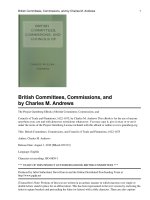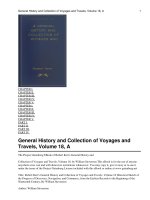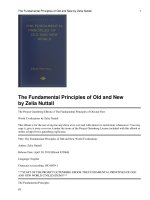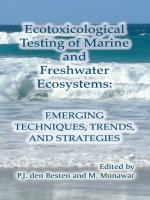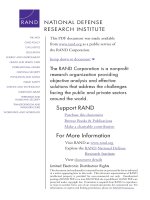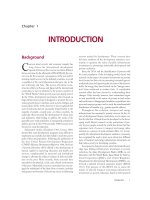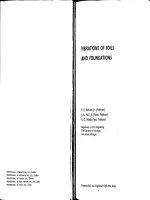Ecotoxicological Testing of Marine and Freshwater Ecosystems: Emerging Techniques, Trends, and Strategies - Chapter 1 docx
Bạn đang xem bản rút gọn của tài liệu. Xem và tải ngay bản đầy đủ của tài liệu tại đây (1.58 MB, 57 trang )
Ecotoxicological Testing of Marine
and Freshwater Ecosystems
Emerging Techniques, Trends,
and Strategies
Edited by
P.J. den Besten and M. Munawar
Boca Raton London New York Singapore
A CRC title, part of the Taylor & Francis imprint, a member of the
Taylor & Francis Group, the academic division of T&F Informa plc.
© 2005 by Taylor & Francis Group, LLC
ECOVISION WORLD MONOGRAPH SERIES
Series Editor
M. Munawar
Managing Editor
I.F. Munawar
© 2005 by Taylor & Francis Group, LLC
Published in 2005 by
CRC Press
Taylor & Francis Group
6000 Broken Sound Parkway NW, Suite 300
Boca Raton, FL 33487-2742
© 2005 by Taylor & Francis Group, LLC
CRC Press is an imprint of Taylor & Francis Group
No claim to original U.S. Government works
Printed in the United States of America on acid-free paper
10 987654321
International Standard Book Number-10: 0-8493-3526-4 (Hardcover)
International Standard Book Number-13: 978-0-8493-3526-6 (Hardcover)
This book contains information obtained from authentic and highly regarded sources. Reprinted material is
quoted with permission, and sources are indicated. A wide variety of references are listed. Reasonable efforts
have been made to publish reliable data and information, but the author and the publisher cannot assume
responsibility for the validity of all materials or for the consequences of their use.
No part of this book may be reprinted, reproduced, transmitted, or utilized in any form by any electronic,
mechanical, or other means, now known or hereafter invented, including photocopying, microfilming, and
recording, or in any information storage or retrieval system, without written permission from the publishers.
For permission to photocopy or use material electronically from this work, please access www.copyright.com
( or contact the Copyright Clearance Center, Inc. (CCC) 222 Rosewood Drive,
Danvers, MA 01923, 978-750-8400. CCC is a not-for-profit organization that provides licenses and registration
for a variety of users. For organizations that have been granted a photocopy license by the CCC, a separate
system of payment has been arranged.
Trademark Notice:
Product or corporate names may be trademarks or registered trademarks, and are used only
for identification and explanation without intent to infringe.
Library of Congress Cataloging-in-Publication Data
Ecotoxicological testing of marine and freshwater ecosystems : emerging techniques, trends, and
strategies/ [edited by] P.J. den Besten, M. Munawar.
p. cm.
Includes bibliographical references and index.
ISBN 0-8493-3526-4 (/05/$0.00+$1.50)
1. Water quality bioassay. 2. Toxicity testing. 3. Marine ecology. 4. Freshwater ecology. I. Besten,
P. J. den. II. Munawar, M. III. Title.
QH90.57.B5E29 2005
577.6'275 dc22
2004022548
Visit the Taylor & Francis Web site at
and the CRC Press Web site at
Taylor & Francis Group
is the Academic Division of T&F Informa plc.
3526 disclaimer.fm Page 1 Thursday, February 10, 2005 9:55 AM
© 2005 by Taylor & Francis Group, LLC
Ecovision Advisory Committee
R. Baudo, Italy
G. Dave, Sweden
P. J. den Besten, the Netherlands
E. de Deckere, Belgium
T. Edsall, U.S.A.
C. vd. Guchte, the Netherlands
R.T. Heath, U.S.A.
M. van der Knaap, the Netherlands
F. Krupp, Germany
S.G. Lawrence, Canada
J.H. Leach, Canada
D.F. Malley, Canada
T. Naganuma, Japan
A.R.G. Price, UK
C.S. Reynolds, U.K.
R.A. Vollenweider, Canada
A.R. Zafar, India
Technical Editors
N.F. Munawar
S.G. Lawrence
Copy Editor
S. Blunt
Cover Design
M. Munawar
J. Dziuba
3526_book.fm Page v Monday, February 14, 2005 1:32 PM
© 2005 by Taylor & Francis Group, LLC
Editor’s Note
M. Munawar
Within the past decade, the Aquatic Ecosystem Health and Management
Society (AEHMS) has been actively engaged in organizing ecotoxicological
symposia and conferences on a variety of themes and topics. The papers
originating from these well-attended scientific gatherings have been pub-
lished by the AEHMS in its journal,
Aquatic Ecosystem Health and Management
,
or via its Ecovision World Monograph Series (Munawar et al. 1995a, 1995b;
Munawar and Luotola 1995). The AEHMS also took a lead by focusing on
sediment toxicity issues and established a Sediment Quality Assessment
(SQA) working group. The SQA working group was charged with organiz-
ing and facilitating integrated and in-depth publications on the discipline.
So far six SQA symposia have been organized across the world in a series
of biennial meetings. The SQA meetings are highly successful, productive,
and have resulted in the publication of several special issues and books
(AEHMS, 1995; 1999a; 1999b; 2000; 2004; Munawar and Dave 1996; Munawar
2003).
Participants in various AEHMS symposia and conferences have asked
for a comprehensive and concise compendium of modern techniques of
aquatic ecosystem health-assessment strategies for professionals who deal
with environmental issues, either in general or within specific fields. An
opportunity to gather material on the current status of ecotoxicological tech-
niques was offered by the 6th International Conference of the AEHMS,
"Aquatic Ecosystem Health: Barometer of Integrity and Sustainable Devel-
opment" (November 4–7, 2001, in Amsterdam),
sponsored by the AEHMS,
the Institute for Inland Water Management and Waste Water Treatment, and
the Netherlands Society of Toxicology.
The concept of sustainable development necessitates the integration of
ecotoxicological sciences with environmental management, legislation, and
policy making. Aquatic ecosystem health assessment is a broad and inte-
grated field of disciplines made up of structural and functional assessments
in the field and laboratory. The field plays a key role in achieving sustain-
ability since water and sediment quality are important prerequisites for the
protection of the environment and human health. There have been several
attempts to publish books on this subject. The AEHMS published a large
3526_book.fm Page vii Monday, February 14, 2005 1:32 PM
© 2005 by Taylor & Francis Group, LLC
compendium of environmental bioassay techniques in 1989 (Munawar et al.
1989). Most of these books, however, focused either on the scientific basis of
ecosystem health assessment or on case studies in which risk-assessment
strategies were demonstrated.
This monograph documents recent innovations and developments,
listed below, in the fields of water and sediment quality assessments. These
fields have integrated considerable advancement in ecotoxicology as well as
in environmental chemistry:
• Chemical assessment of bioavailability
• Biosensor techniques to detect specific groups of contaminants
• Bioassays more relevant to species diversity or exposure routes
• Integrative approaches
• Modeling of bioaccumulation and consequences of sediment or water
toxicity at higher trophic levels
• Communication strategies that focus on risk perception by the public,
investigators, policy makers, and government agencies
All papers included in this monograph were invited and peer reviewed
by a panel of international referees, using standard AEHMS publication
guidelines. Accepted manuscripts were meticulously revised by authors,
reviewed by the coeditors, and edited for technical and linguistic issues by
the technical editor. We hope that this collection of papers provides a holistic
and timely picture of the fast-changing field of ecotoxicological testing and
is useful to toxicologists, environmentalists, researchers, managers, and pol-
icy makers across the world.
I sincerely thank Dr. P.J. den Besten of the Institute for Inland Water
Management and Waste Water Treatment for his devotion, hard work, and
cooperation that resulted in the preparation and publication of this landmark
book. I also thank Nabila F. Munawar, Sharon Lawrence, Iftekhar F.
Munawar, Susan Blunt, and Calais Irwin for their assistance in the processing
of this book. Thanks also to Randi Cohen for her interest, encouragement,
and assistance in the publication of this book with Taylor & Francis/CRC
Press.
References
AEHMS (Aquatic Ecosystem Health and Management Society). J. Aquat. Ecosyst.
Health 4(3), 133-216, 1995.
AEHMS.
Sediment Quality Assessment: Tools, Criteria and Strategies (special. issue).
Aquat. Ecosyst. Health Mgmt. 2(4), 345-484, 1999a.
AEHMS.
Integrated Toxicology (special issue)
. Aquat. Ecosyst. Health Mgmt. 2(1), 1-
71, 1999b.
AEHMS. Aquat. Ecosyst. Health Mgmt. 3(3), 277-430, 2000.
AEHMS.
Assessing Risks and Impacts of Contaminants in Sediments (special issue)
. Aquat.
Ecosyst. Health Mgmt. 7(3), 335-432, 2004.
3526_book.fm Page viii Monday, February 14, 2005 1:32 PM
© 2005 by Taylor & Francis Group, LLC
Munawar, M. (Ed.).
Sediment Quality Assessment and Management: Insight and Progress.
Ecovision World Monograph Series. Aquatic Ecosystem Health and Manage-
ment Society, Canada, 361 pp. 2003.
Munawar, M., Dave, G. (Eds.).
Development and Progress in Sediment Quality Assess-
ment: Rationale, Challenges, Techniques and Strategies.
Ecovision World Mono-
graph Series. SPB Academic Publishers, the Netherlands, 255 pp. 1996.
Munawar, M., Luotola, M. (Eds.).
The Contaminants in the Nordic Ecosystem: the
Dynamics, Progress and Fate.
Ecovision World Monograph Series. SPB Aca-
demic Publishing, the Netherlands, 276 pp. 1995.
Munawar, M., Dixon, G., Mayfield, C.I., Reynoldson, T, Sadar, M.H., (Eds.).
Environ-
mental Bioassay Techniques and their Application.
Hydrobiologia, 188/189,
680pp. 1989.
Munawar, M., Chang, P., Dave, G., Malley, D., Munawar, S., Xiu, R., (Eds.).
Aquatic
Ecosystems of China: Environmental and Toxicological Assessment.
Ecovision
World Monograph Series. SPB Academic Publishing, the Netherlands, 119 pp.
1995a.
Munawar, M., Hanninen, O., Roy, S., Munawar, N., Karenlampi. L., Brown, D., (Eds.).
1995b.
Bioindicators of Environmental Health.
Ecovision World Monograph Se-
ries. SPB Academic Publishing, the Netherlands, 265 pp. 1995b.
3526_book.fm Page ix Monday, February 14, 2005 1:32 PM
© 2005 by Taylor & Francis Group, LLC
Foreword
G. Dave
During the last 50 years most of us have realized that the “the solution to
pollution is not dilution.” Books like
Silent Spring
and
The Frail Ocean
and
TV programs by Jacques Cousteau have alerted scientists, decision-makers,
and the public to the threat of chemicals to environmental health. We have
added other threats like acidification, eutrophication, overexploitation of
natural resources (biological as well as geophysical), and global warming.
We have also realized that the environment is a very complex system in
which unexpected events may occur, such as eggshell thinning caused by
chlorinated hydrocarbons and imposex in gastropods caused by tributyl tin.
These examples illustrate the need for precautionary principles.
Experience has shown that the majority of environmental problems are
of global concern, and that we need international cooperation to solve them.
This is certainly the case for the marine environment. In many parts of the
world it is overexploited while it also suffers from pollution, illustrating the
“tragedy of the commons.” Cooperation does work, and has resulted in
positive action at international, national, regional, and local levels. The uni-
fying principle of the Rio conference in 1992, “think globally, act locally,”
and the acceptance of Agenda 21 have certainly affected the Aquatic Eco-
system Health and Management Society (AEHMS). The AEHMS has acted
globally by organizing conferences and publishing the journal
Aquatic Eco-
system Health and Management.
The AEHMS has also produced numerous
special issues and peer-reviewed books such as this monograph and the
Ecovision World Monograph Series (
This book is one of several important steps toward a better understand-
ing of the effects of chemicals and assessment of ecosystem health. During
the last decade there has been an increasing emphasis on monitoring of
biological parameters in the aquatic environment. This may be seen as a shift
in emphasis from laboratory studies and toxicity tests toward field studies
and bioassays, and from measurements of concentrations of pollutants
toward measurements of biological diversity and ecological function and
interaction. However, these changes in focus should be complementary and
not occur at the expense of each other. The complexity of aquatic ecosystems
requires consideration of both exposure to chemicals and effects of chemicals,
3526_book.fm Page xi Monday, February 14, 2005 1:32 PM
© 2005 by Taylor & Francis Group, LLC
as well as the interaction between organisms and the influence of confound-
ing factors such as weather and climate. We also need to communicate these
matters to decision-makers and the public.
The chapters of this book present various methods that can be used to
improve our understanding of the aquatic environment and its response to
disturbances. The book as a whole promotes the understanding of the struc-
ture, function, and performance of healthy and damaged aquatic ecosystems
(freshwater, marine, and estuarine) from integrated, multidisciplinary, and
sustainable perspectives, and explores the complex interactions between
human society, ecology, development, politics, and the environment. This
makes the book a valuable contribution to the ideas and philosophy of our
society and to the AEHMS in particular.
3526_book.fm Page xii Monday, February 14, 2005 1:32 PM
© 2005 by Taylor & Francis Group, LLC
Preface
P.J. den Besten and M. Munawar
Over the past 25 years the discipline of ecotoxicology has undergone two
major developments. Firstly, new assays have been developed, deploying
organisms that bear added relevance to the specific environment under
investigation. Several new procedures assess the effects on organisms after
exposure to environmental samples rather than to spiked water or sediment
samples. Also noteworthy is the considerable attention given to effects of
chronic exposure to low levels of contaminants. These developments are of
great importance for the application of ecotoxicological techniques in risk-
assessment approaches. They create new possibilities for building lines of
evidence as part of weight of evidence (WOE) approaches (Burton et al.
2002). Secondly, progress is apparent from the increased attention given to
effecting measurements at different levels of biological organization. Includ-
ing new endpoints in assays at the cellular, subcellular, or molecular level
may increase the sensitivity, specificity, or throughput capacity of the assays.
Such developments will prove to be crucial steps in the application of screen-
ing steps in water and sediment quality assessment. Furthermore, these
techniques may help to build prognostic tools that can be used in early-
warning systems (den Besten 1998).
Almost 15 years ago, a state-of-the-art assessment of environmental bio-
assays and their applications was published (Munawar et al. 1989). Since
then several other books with different scopes about the scientific back-
ground of ecotoxicology and its application in environmental risk assessment
have appeared.
This book is intended to capture the progress and develop-
ments made in this field since 1989.
Most chapters focus on the impairment of aquatic ecosystem health due
to the pollution of water and sediments. However, it is clear that there are
many more stressors that can threaten aquatic ecosystems. Impacts by
human activities can also be observed at different scales, from local to global.
Direct impacts occur through catchment runoff, discharge of wastes, atmo-
spheric deposition of pollutants, eutrophication, overexploitation, and hab-
itat modification. Insidious impacts include the spread of introduced species
and manifestations of global warming. A special chapter in this book deals
with the role of remote sensing technologies in monitoring, predicting, and
3526_book.fm Page xiii Monday, February 14, 2005 1:32 PM
© 2005 by Taylor & Francis Group, LLC
managing changes within coastal ecosystems. Important improvements in
information technology and data processing make possible the assessment
of spatial variability.
The information from ecotoxicological assessments is used to make rec-
ommendations to preserve, enhance, or restore ecosystem functions. Deci-
sions regarding the commitment of political or resource expenditures nec-
essary to implement these recommendations are often made by nontechnical
experts such as elected officials in consultation with the public. These audi-
ences are often unfamiliar with the data and techniques used to assess
aquatic ecosystems. It is important that assessment results be effectively
communicated in comprehensible terms and language to ensure that deci-
sion-makers and the public are making informed choices. Therefore, this
book contains a chapter describing
the background of risk perception and
communication. This information should show scientists how to effectively
communicate the outcome of their risk assessments.
Ecotoxicological testing of water and sediment implies that the quality
of water and sediment is not only based on information from chemical
analyses, but also (or as a first step) on effect measurements. Effect measure-
ments are in this respect usually referred to as bioassays or toxicity tests.
The terms effect-based water quality assessment and effect-based sediment
quality assessment are used to underscore the change from the classical
chemical approaches. Effect-based water and sediment quality assessments
have been implemented in different countries to a variable degree. Generally
speaking, effect monitoring is gaining importance in the following water
and sediment management tasks:
• Surface water quality assessment
• Drinking water quality assessment
•Wastewater quality assessment (before and after treatment)
• Sediment quality assessment (decision frameworks for remediation)
•Dredged material quality assessment (for selecting disposal options)
The reason for the increasing importance of effect-based quality assess-
ment is that we generally know the identity of just a small percentage of the
chemicals that are released into the environment. Furthermore, it is obvious
that the presence of chemical substances in the environment is important for
the ecosystem because effects occur, and not just because the chemicals are
present. For example, most chemical analyses do not include an evaluation
of the biological availability, even though this is essential information for
understanding the actual risks. When quality assessment is also based on
effect measurements, important information about availability and about
unknown toxic compounds is included in the evaluation.
The focus of this book is on ecotoxicological testing of water and sedi-
ment quality in both freshwater and marine waters. In many cases, effect-
based quality assessment approaches include field surveys of pelagic or
benthic invertebrates or wildlife populations (offspring size, bioaccumula-
3526_book.fm Page xiv Monday, February 14, 2005 1:32 PM
© 2005 by Taylor & Francis Group, LLC
tion levels, and so on). The expertise involved in this work is partly from
ecology and partly from ecotoxicology, and thus is not entirely outside the
scope of this book. However, this book is primarily dedicated to recent
developments in bioassays (toxicity tests with water or sediment samples)
and new technologies such as gene-expression analysis and remote sensing.
It also contains a description of techniques included as appendices at the
end of some of the chapters, enabling the reader to understand and compre-
hend the strengths and limitations of various techniques and providing
access to additional literature. An overview and synthesis of the current
status of techniques and strategies is included in the last chapter.
This book focuses on the following topics:
• Emerging fields of research on biomarkers, genome expression, mul-
tispecies tests, and tiered approaches
• Experimentally oriented strategy (although the book does not contain
information about ecology)
• Overview of methods for processing and integration of data, risk
communication, and risk perception
• Use of information from biological testing in decision- and policy-
making
• Selected and simple proven techniques that may be used for testing
and training purposes (in the appendices)
The reader may find some inconsistencies in the terms and definitions
used by the different authors for specific techniques, such as toxicity test,
bioassay, biosensor, and so on. In the opinion of the editors, these differences
reflect personal views on the roles these techniques may play in risk assess-
ment. Tests can be chemically oriented, focusing on the mode of action of a
toxic compound, or be ecologically oriented, aimed to link cause and effect
observed in the field. Since this book is not intended to reach agreement in
the definition of those terms and techniques, occasional differences among
the chapters should be interpreted as the personal preferences of the authors.
References
Burton, G.A., Jr., Batley, G.E., Chapman, P.M., Forbes, V.E., Smith, E.P., Reynoldson,
T., Schlekat, C.E., den Besten, P.J., Bailer, J., Green, A.S., and Dwyer, R.L., 2002.
A weight-of-evidence framework for assessing ecosystem impairment: im-
proving certainty in the decision-making process.
Human Ecol. Risk Assess-
ment,
8, 1675–1696.
den Besten, P.J., 1998. Concepts for the implementation of biomarkers in environ-
mental monitoring,
Mar. Environ. Res.
46, 253–256.
Munawar, M., Dixon, G., Mayfield, C.I., Reynoldson, T., and Sadar, M.H., (Eds.) 1989.
Environmental bioassay techniques and their application.
Hydrobiologia,
188/189.
3526_book.fm Page xv Monday, February 14, 2005 1:32 PM
© 2005 by Taylor & Francis Group, LLC
Contributors
P.J. den Besten
Institute for Inland Water
Management and Waste Water
Treatment
Ministry of Transport, Public Works
and Water Management
PO Box 17
8200 AA Lelystad
The Netherlands
N.W. van den Brink
Centre for Ecosystem Studies
PO Box 47
6700 AA Wageningen,
The Netherlands
A. Brouwer
BioDetection Systems BV and
Institute for Environmental Studies
(IVM)
Badhuisweg 3
1031 CM Amsterdam,
The Netherlands
and
Institute for Environmental Studies
(IVM)
Vrije Universiteit
De Boelelaan 1087
1081 HV Amsterdam
The Netherlands
B. van der Burg
BioDetection Systems BV
Badhuisweg 3
1031 CM Amsterdam
The Netherlands
W.M. De Coen
Laboratory for Ecophysiology,
Biochemistry and Toxicology
University of Antwerp
Groenenborgerlaan 171, B-2020
Antwerp
Belgium
G. Dave
Department of Applied
Environmental Science
University of Goteborg
Goteborg
Sweden
K.T. Ho
Department of Applied
Environmental Science
University of Goteborg
Box 464
405 30 Goteborg
Sweden
D.S. Ireland
U. S. Environmental Protection
Agency
Chicago, Illinois
United States
3526_book.fm Page xvii Monday, February 14, 2005 1:32 PM
© 2005 by Taylor & Francis Group, LLC
K. Koop
New South Wales Department of
Environment & Conservation
Sydney South, NSW
Australia
A. Lange
University of Antwerp
Laboratory for Ecophysiology,
Biochemistry and Toxicology
Groenenborgerlaan 171, B-2020,
Antwerp
Belgium
D. Leverett
Environment Agency, National
Centre for Ecotoxicology and
Hazardous Substances
4 The Meadows,
Waterberry Drive
Waterlooville, Hampshire
P07 7XX
United Kingdom
M. Maras
University of Antwerp
Laboratory for Ecophysiology,
Biochemistry and Toxicology
Groenenborgerlaan 171, B-2020
Antwerp
Belgium
M. Munawar
Fisheries & Oceans Canada
Burlington, Ontario
Canada
R. van der Oost
DWR, Institute for Water
Management and Sewerage
Environmental Toxicology
PO Box 94370
1090 GJ Amsterdam
The Netherlands
L. Pelstring
Damage Assessment Center
National Oceanic and Atmospheric
Administration
Silver Spring, Maryland
United States
T.R. Pritchard
University of Waikato
Hamilton
New Zealand
M.R. Reiss
U.S. Environmental Protection
Agency
New York, New York
United States
M. Tonkes
Institute for Inland Water
Management and Waste Water
Treatment
Ministry of Transport, Public Works
and Water Management
PO Box 17
8200 AA Lelystad
The Netherlands
C. Porte-Visa
Environmental Chemistry
Department
IIQAB-CSIC
C/ Jordi Girona, 18
08034 Barcelona
Spain
3526_book.fm Page xviii Monday, February 14, 2005 1:32 PM
© 2005 by Taylor & Francis Group, LLC
Contents
Chapter one Toxicity tests for sediment quality assessments 1
D.S. Ireland and K.T. Ho
Chapter two Bioassays and tiered approaches for monitoring
surface water quality and effluents 43
M. Tonkes, P.J. den Besten, and D. Leverett
Chapter three Biomarkers in environmental assessment 87
R. van der Oost, C. Porte-Visa, and N.W. van den Brink
Chapter four Molecular methods for gene expression analysis:
ecotoxicological applications 153
A. Lange, M. Maras, and W.M. De Coen
Chapter five Bioassays and biosensors: capturing biology in
a nutshell 177
B. van der Burg and A. Brouwer
Chapter six Satellite remote sensing in marine ecosystem
assessments 195
T.R. Pritchard and K. Koop
Chapter seven Risk perception and public communication of
aquatic ecosystem assessment information 229
M.R. Reiss and L. Pelstring
Chapter eight Ecotoxicological testing of marine and freshwater
ecosystems: synthesis and recommendations 249
P.J. den Besten and M. Munawar
3526_book.fm Page xix Monday, February 14, 2005 1:32 PM
© 2005 by Taylor & Francis Group, LLC
1
chapter one
Toxicity tests for sediment
quality assessments
D.S. Ireland and K.T. Ho
Contents
Introduction 2
The need for toxicity tests in sediment quality assessments 2
Assessment approaches 5
Tiered testing approaches 5
Applications of sediment toxicity tests 5
Sediment sampling 9
Sample design 9
Sample collection, processing, transport, and storage 10
Sample manipulation 12
Recommended procedures for both freshwater and marine test
organisms 14
Interpretation 17
Laboratory versus field exposures: what is the ecological
relevance? 17
Future research recommendations 23
Summary 24
Acknowledgments 24
References 25
Appendix 36
Toxicity tests for sediment quality assessments 36
Freshwater test organisms 36
Hyalella azteca
36
Chironomus riparius
38
Marine test organisms 39
Ampelisca abdita
39
Microtox 41
References 41
3526_book.fm Page 1 Monday, February 14, 2005 1:32 PM
© 2005 by Taylor & Francis Group, LLC
2 Ecotoxicological testing of marine and freshwater ecosystems
Introduction
Toxic sediments have contributed to a wide variety of environmental prob-
lems around the world. The observed effects include direct toxic effects to
aquatic life, biomagnification of toxicants in the food chain, and economic
impacts. This chapter discusses the use of toxicity tests as an integral part
of contaminated sediment assessments, and summarizes the use of sediment
toxicity testing in existing tiered regulatory guidance for addressing toxic
sediments and dredge spoils in several countries. Sampling design, collec-
tion, handling, and storage of sediments for toxicity testing are discussed in
relation to the project objectives.
A number of sediment toxicity tests exist for both fresh and marine
waters. A brief description of the type of test, collection method for the test
organism, volume of test material needed, suitable test matrix, level of stan-
dardization, and references where detailed methodology can be found are
also included in this chapter. Several studies are highlighted that discuss the
ecological significance of toxicity testing, and recommendations for future
research in the area are included.
The need for toxicity tests in sediment quality assessments
Sediment is an integral component of aquatic ecosystems, providing habitat,
feeding, spawning, and rearing areas for many aquatic organisms. In aquatic
systems, sediments accumulate anthropogenic (man-made) chemicals and
waste materials, particularly persistent organic and inorganic chemicals.
These accumulated chemicals are then reintroduced into waterways (USEPA
1998) and have contributed to a variety of environmental problems. Con-
taminated sediments may be directly toxic to sediment-dwelling organisms
or be a source of contaminants for bioaccumulation in the food chain. The
direct effects of contaminated sediments can be obvious or subtle. Evident
effects include loss of important fish and shellfish populations (USEPA 1998);
decreased survival, reduced growth, and impaired reproduction in benthic
invertebrates and fish (USEPA 2002); and fin rot and increased tumor fre-
quency in fish (Van Veld et al. 1990). Adverse effects on organisms in or near
sediment can occur even when contaminant levels in the overlying water
are low (Chapman 1989).
More subtle effects resulting from contaminated sediments include
changes in composition of benthic invertebrate communities from sensitive
to pollution-tolerant species and decreases in aquatic system biodiversity
(USEPA 1998). Tolerant species may process contaminants in a variety of
ways, and the resulting novel metabolic pathways and products may affect
ecosystem functions such as energy flow, productivity, and decomposition
processes (Griffiths 1983).
Loss of any biological community in the ecosystem can indirectly affect
other components of the system. For example, if the benthic community is
significantly changed, nitrogen cycling might be altered such that forms of
3526_book.fm Page 2 Monday, February 14, 2005 1:32 PM
© 2005 by Taylor & Francis Group, LLC
Chapter one: Toxicity tests for sediment quality assessments 3
nitrogen necessary for key phytoplankton species are lost and replaced with
blue-green algae, capable of nitrogen fixation (Burton et al. 2002). Many
examples of direct impacts of contaminated sediment on wildlife and
humans have been noted. Bishop et al. (1995, 1999) found good correlations
between a variety of chlorinated hydrocarbons in sediment and concentra-
tions in bird eggs. These researchers found that this relationship indicated
that the female contaminant body burden was obtained locally, just prior to
egg-laying. Other studies by Bishop et al. indicated a link between exposure
of snapping turtle (
Chelydra s. serpentina
) eggs to contaminants (including
sediment exposure) and developmental success (Bishop et al. 1991, 1998).
Contaminated sediments can also be a source of chemicals for bioaccu-
mulation in the food chain (USEPA 2000a; ASTM 2002a). Contaminants may
be bioaccumulated by transport of dissolved contaminants in interstitial
water (ITW — sometimes referred to as pore water) across biological mem-
branes and/or the ingestion of contaminated food or sediment particles with
subsequent transport across the gut. For upper-trophic–level species, inges-
tion of contaminated food is the predominant route of exposure, especially
to hydrophobic chemicals; it is through the ingestion of contaminated fish
and shellfish that human health can be impacted from contaminated sedi-
ments. Other investigations of environmentally persistent organic com-
pounds (chlorinated hydrocarbons) have shown bioaccumulation and a
range of effects in the mud puppy,
Necturus maculosus
(Bonin et al. 1995;
Gendron et al. 1997). For humans, there is evidence that chronic exposure
to significant quantities of polychlorinated biphenyls (PCBs) via consump-
tion of freshwater fish results in low–birth-weight infants, reduced head
circumference, and delays in developmental maturation at birth (Swain
1988). In fact, fish consumption represents the most significant route of
aquatic exposure of humans to many metals and organic compounds
(USEPA 1992a). In addition there is anecdotal evidence from cases like Mon-
guagon Creek, a small tributary of the Detroit River, where incidental human
contact with the sediment resulted in a skin rash (Zarull et al. 1999).
Consequently, contaminated sediments in aquatic ecosystems pose
potential hazards to sediment-dwelling organisms (epibenthic and in-faunal
invertebrate species), aquatic-dependent wildlife species (fish, amphibians,
reptiles, birds, and mammals), and humans (USEPA 2002; MacDonald et al.
2002a, 2002b).
In addition to animal health, human health, and ecological impacts,
contaminated sediments may cause severe economic effects. Economic
impacts may be felt by the transportation, tourism, and fishing industries.
In one Great Lakes harbor (the Indiana Harbor Ship Canal), navigational
dredging has not been conducted since 1972 “due to the lack of an approved
economically feasible and environmentally acceptable disposal facility for
dredged materials” from the canal (USACE 1995). The accumulation of sed-
iment in this canal has increased costs for industry. Ships carrying raw
materials have difficulty navigating in the harbor and canal. In addition,
ships come into the harbor loaded at less-than-optimum vessel drafts. The
3526_book.fm Page 3 Monday, February 14, 2005 1:32 PM
© 2005 by Taylor & Francis Group, LLC
4 Ecotoxicological testing of marine and freshwater ecosystems
use of various docks is restricted, requiring unloading at alternative docks
and double-handling of bulk commodities to the preferred dock. These prob-
lems are causing increased transportation costs of waterborne commerce in
this canal, estimated in 1995 to be $12.4 million annually (USACE 1995).
Assessments of sediment quality commonly include the analyses of
anthropogenic contaminants (sediment chemistry), geochemical factors that
affect bioavailability, benthic community structure, and direct measures of
toxicity (toxicity tests). All of these measures provide useful and unique
information relating to the quality of the sediment. However, sediment
chemistry measurements alone might not accurately reflect risk to the envi-
ronment (USEPA 2000b). Bioavailability of chemicals in sediment is a func-
tion of the chemical class and of speciation and geochemical factors, as well
as the behavior and physiology of the organism. In addition, complex chem-
ical analyses are often impractical, expensive, and in many cases almost
impossible due to the high number of unknown contaminants. Benthic com-
munity surveys may be inadequate because they can fail to discriminate
between effects of contaminants and effects from noncontaminant factors
(for example, physical parameters such as salinity and flow).
Sediment toxicity tests allow a direct measure of sediment toxicity or
bioaccumulation by exposing surrogate organisms to sediments under con-
trolled conditions (ASTM 2002b; USEPA 2000b, 2001a). These tests have
evolved into standardized, effective tools providing direct, quantifiable evi-
dence of biological consequences of sediment contamination that can only
be inferred from chemical or benthic community analyses (ASTM 2002b;
USEPA 2000b, 2001a). Some advantages of sediment toxicity tests are that
they measure the bioavailable fraction of contaminants, they require limited
special equipment, they can be applied to all chemicals of concern, and tests
applied to field samples reflect cumulative effects of contaminants and con-
taminant interactions (ASTM 2002b; USEPA 2000b, 2001a). Some disadvan-
tages of using sediment toxicity tests are that natural geochemical charac-
teristics of sediment may affect the response of test organisms, indigenous
animals may be present in field-collected sediments, tests applied to field
samples may not discriminate effects of individual chemicals, and few com-
parisons have been made of methods or species (ASTM 2002b; USEPA 2000b,
2001a).
Traditionally, sediment toxicity test data have been expressed as a per-
centage of survival in comparison to a control or reference for indicator
organisms exposed to the field-sampled sediment in laboratory toxicity tests
(ASTM 2002b, 2002c, 2002d; USEPA 1994a, 1994b, 2000b, 2001a). Methods
for testing the short- and long-term toxicity of sediment samples to benthic
freshwater and marine organisms have been developed (see reviews in API
1994; Burton et al. 1992; Lamberson et al. 1992; USEPA 1994a, 1994b, 2000b,
2001a). More recently, sublethal measurements (reduction in survival,
growth, and reproduction ) are also being used (Ingersoll et al. 2001).
3526_book.fm Page 4 Monday, February 14, 2005 1:32 PM
© 2005 by Taylor & Francis Group, LLC
Chapter one: Toxicity tests for sediment quality assessments 5
Assessment approaches
Tiered testing approaches
Tiered testing refers to a structured, hierarchical procedure for determining
data needs relative to decision-making that consists of a series of tiers (levels
or steps) of investigative intensity. Tiered testing represents a logical, tech-
nically sound approach for evaluating contaminated sediments and is used
in a variety of regulatory programs throughout the world (including those
described below). Typically, increasing tiers in a tiered testing framework
involve increased information and decreased uncertainty (USEPA 1998). The
objective of the tiered testing approach is to make optimal use of resources
in generating the information necessary to make a contaminant determina-
tion, using an integrated chemical, physical, and biological approach. The
initial tier uses available information that may be sufficient for completing
the evaluation in some cases. Evaluation at successive tiers requires infor-
mation from tests of increasing sophistication and cost. For example, some
frameworks prescribe the use of short-term (acute) sediment toxicity tests
in tier 2, and long-term (chronic) sediment toxicity tests as well as bioaccu-
mulation tests in tier 3. If the information gathered in a tier is inadequate to
make a decision, testing proceeds through subsequent tiers of more extensive
and specific testing until sufficient information is generated to support a
decision. The most logical and cost-efficient approach is to enter tier one and
proceed as far as necessary to make a determination.
The general conclusions that are made at each of the tiers is that either
the available information either is or is not sufficient to make a contaminant
determination. With the tiered testing structure, it is not usually necessary
to obtain data for all tiers to make a contaminant determination. It may also
not be necessary to conduct every test described within a given tier to have
enough information for a determination. The underlying philosophy is that
only that data necessary for a determination should be acquired.
Applications of sediment toxicity tests
All sediment toxicity tests are undertaken for a specific reason and most are
done for some type of regulatory purpose. This may include support for
sediment remediation; dredged material disposal; sediment monitoring; and
in the U.S., possible support for total maximum daily loads (TMDLs) and
natural resource damage assessments (NRDAs). Numerous regulations exist
throughout the world that authorize programs for addressing contaminated
sediments. A few of these regulations and frameworks that use toxicity tests
include dredged material disposal in the U.S., Canada, and Australia, and
sediment remediation in the U.S This is not meant to be all-inclusive, but
serves to provide some examples.
In most navigational dredging situations, the decision has been made
that the material will be moved. The question is whether or not the material
3526_book.fm Page 5 Monday, February 14, 2005 1:32 PM
© 2005 by Taylor & Francis Group, LLC
6 Ecotoxicological testing of marine and freshwater ecosystems
can be disposed of in an unrestricted fashion (no treatment of the material)
in open water as opposed to in some type of confined disposal facility (either
on land or in the water). In the U.S., the U.S. Environmental Protection
Agency (USEPA) and U.S. Army Corps of Engineers (USACE) are responsi-
ble for governing the regulatory program concerned with evaluating navi-
gation dredged material. About 400 million cubic yards (roughly 500 million
tons) of sediment are dredged annually in the U.S. to maintain more than
400 ports and 25,000 miles of navigation channel. Dredged material trans-
ported for disposal at ocean sites is regulated by Section 103 of the Marine
Protection, Research and Sanctuaries Act (MPRSA). Guidance for conducting
evaluations for material being proposed for ocean disposal is described in
Evaluation of Dredged Material Proposed for Ocean Disposal — Testing Manual
(USACE/USEPA 1991), otherwise known as the Ocean Testing Manual
(OTM). The dredged material unsuitable for ocean disposal is either placed
in upland environments (confined disposal facilities) or is managed within
the aquatic environment rather than disposed of in open water. Dredged
material that is proposed to be managed within the aquatic environment
landward of the baseline of the territorial sea is regulated under Section 404
of the Clean Water Act (CWA). Guidance for conducting evaluations under
Section 404 is contained in
Evaluation of Dredged Material Proposed for Dis-
charge in Waters of the U.S. — Testing Manual
(USACE/USEPA 1998), other-
wise known as the Inland Testing Manual (ITM).
The same evaluative framework is used in the OTM and the ITM to
characterize exposure and effects. The framework uses a tiered approach, as
outlined above, proceeding through subsequent tiers until there is sufficient
information to determine if the material would cause unacceptable impacts
in the aquatic environment. Tier 1 involves the collection and analysis of
existing information on the physical, chemical, and biological properties of
the material in question. Tier 2 involves the collection and use of chemical
data. In tier 3 and tier 4, sediment toxicity tests are conducted to assist in
the decision-making process regarding the disposal of dredged material.
Toxicity tests with whole sediments are designed to determine whether
dredged material is likely to produce unacceptable adverse effects on benthic
organisms. In these tests, the test animals are exposed to whole sediments,
and the effects (lethality in tier 3 and sublethality in tier 4) are recorded. For
whole-sediment toxicity tests, both the OTM and the ITM recommend the
use of three sensitive species, representing a filter feeder, a deposit feeder,
and a burrowing organism (where possible). If only two different species are
tested they should, together, cover the above three life-history strategies.
Additional information on the test requirements can be found in the OTM
and the ITM.
The OTM and the ITM also provide information necessary to estimate
the potential for bioaccumulation. A bioaccumulation test in tier 3 is nor-
mally conducted only when there is a reason to believe that specific chemicals
of concern may be accumulated in the tissues of target organisms (USACE/
USEPA 1998). Both the OTM and the ITM require two 28-day bioaccumula-
3526_book.fm Page 6 Monday, February 14, 2005 1:32 PM
© 2005 by Taylor & Francis Group, LLC
Chapter one: Toxicity tests for sediment quality assessments 7
tion tests utilizing species from two different tropic niches (where possible),
representing a suspension-feeding/filter-feeding and a burrowing deposit-
feeding organism (USACE/USEPA 1991, 1998). If results of the bioaccumu-
lation test in tier 3 are indeterminate, further testing may be required in tier
4, recognizing that an exposure period of 28 days may not be sufficient for
the selected test species to achieve a steady-state tissue concentration in the
normal tier 3 bioaccumulation test. In a tier 4 bioaccumulation test, testing
may be done in the lab or in rare cases in the field, and testing options may
also include time-sequenced laboratory exposures in excess of the standard
28 days in order to reach a steady-state concentration (USACE/USEPA 1998).
The management of dredged material disposal in Canada for marine
sediments follows a similar tiered structure as in the U.S Each year in
Canada, 2 to 3 million tons of material are disposed of at sea. Most of this
is for keeping shipping channels and harbors clear for navigation and com-
merce. Environment Canada administers the control of disposal at sea under
the Canadian Environmental Protection Act, 1999 (CEPA). This permitting
system applies to both marine and internal marine waters and lives up to
the commitments made under the 1996 Protocol to the Convention on the
Prevention of Marine Pollution by Dumping of Wastes and Other Matter
(known as the London Convention). The assessment framework used for
controlling material for open-water disposal mirrors the Waste Assessment
Guidance of the 1996 Protocol and has been reproduced in the CEPA. Mate-
rial not suitable for disposal at sea may be left in place, or disposed of or
treated on land under various other jurisdictions. Similar to the U.S., eval-
uations are conducted in a tiered approach and proceed through subsequent
tiers until there is sufficient information to determine if the material would
cause unacceptable impacts in the aquatic environment. The exposure path-
ways to support this determination include both whole-sediment and ITW
tests using three marine or estuary sediment bioassays, including an acute
lethality test (Environment Canada 1998a) and two sublethal tests (Environ-
ment Canada 2001a); or one sublethal test and one bioaccumulation test
(USEPA 1993a). Species were originally selected to be both representative of
Canadian environments and ecologically important. Additional information
on this framework can be found in the Canadian Disposal at Sea Regulations
(Environment Canada 2001b).
In May 2002, Environment Australia released the National Ocean Dis-
posal Guidelines for Dredged Material (Environment Australia 2002). Like
Canada, Australia is party to the London Convention (ratified in December
2000), and under the Environment Protection (Sea Dumping) Act 1981 (the
Sea Dumping Act), Australia implements the protocol of the London Con-
vention by regulating the dumping of wastes and other matter into the sea.
The Sea Dumping Act provides the basis for the permitting and ongoing
management of such actions. These guidelines are intended to provide a
comprehensive framework to assess potential environmental impacts from
disposing dredged material at sea in accordance with the Sea Dumping Act
and other environmental protection legislation, including the Environment
3526_book.fm Page 7 Monday, February 14, 2005 1:32 PM
© 2005 by Taylor & Francis Group, LLC
8 Ecotoxicological testing of marine and freshwater ecosystems
Protection and Biodiversity Conservation Act 1999 and Australia’s interna-
tional obligations (Environment Australia 2002). Under these guidelines,
Australia has developed a tiered approach for assessing sediment contami-
nation using four phases. Sediment toxicity testing is in phase three (acute
toxicity) and phase four (subacute or chronic toxicity). Protocols for conduct-
ing these test are outlined in the Australian and New Zealand Guidelines
for Fresh and Marine Water Quality (ANZECC/ARMCANZ 2000). The
National Ocean Disposal Guidelines for Dredged Material states that sedi-
ment toxicity testing, using protocols based on those developed by USEPA
(the OTM and the ITM outlined above) or by the American Society for Testing
and Materials (ASTM), is considered the best available method for predicting
the bioavailability and subsequent toxicity potential of contaminated sedi-
ments for open-sea disposal of dredged material. Whole-sediment tests are
preferred, where available, because the water tests available are not neces-
sarily on the most ecologically relevant species (Environment Australia
2002). As stated above, further details on toxicity testing are set out in
ANZECC/ARMCANZ (2000).
The U.S. Comprehensive Environmental Response, Compensation and
Liability Act of 1980 (CERCLA, often referred to as Superfund) as amended
by the Superfund Amendments and Reauthorization Act of 1986 (SARA)
provides one of the most comprehensive authorities available to the USEPA
for obtaining sediment cleanup, reimbursement of USEPA cleanup costs, and
compensation to natural resource trustees for damages by contaminated
sediments. The USEPA Superfund program carries out the Agency’s man-
date under CERCLA/SARA. The primary regulation issued by the Super-
fund program is the National Oil and Hazardous Substances Pollution Con-
tingency Plan (NCP). To date, about 300 sites (approximately 20%) on the
Superfund National Priorities List (NPL) — the list of national priorities
among the known releases or threatened releases of hazardous substances,
pollutants, or contaminants throughout the U.S. based on a hazard-ranking
system — appear to have some kind of contaminated sediment (USEPA
2004). To assist in identifying sites where the risks to human health or the
environment are unacceptable due to sediment contamination, the USEPA
has recently developed and published guidance for conducting Ecological
Risk Assessments (ERAs) within the Superfund program (USEPA 1997).
ERAs are most often conducted by the USEPA during the Remedial Inves-
tigation/Feasibility Study (RI/FS) phase of the Superfund response process
and are composed of eight steps or phases. These ERAs are used to evaluate
the likelihood of adverse ecological effects occurring as a result of exposure
to any physical, chemical, or biological entities that can induce adverse
responses at a site. Steps 1 and 2 involve the compilation of existing infor-
mation, steps 3 through 6 are data collection, step 7 is risk characterization,
and step 8 is risk management.
Sediment toxicity tests are commonly used in ERAs to assist in deter-
mining if there is an unacceptable risk from sediment contamination. During
step 3 (problem formulation), assessment endpoints are selected. These end-
3526_book.fm Page 8 Monday, February 14, 2005 1:32 PM
© 2005 by Taylor & Francis Group, LLC
Chapter one: Toxicity tests for sediment quality assessments 9
points are an explicit expression of the environmental value (species, eco-
logical resource, or habitat type) that is to be protected. Often, these are
difficult to measure directly; therefore, in the case of contaminated sedi-
ments, a sediment toxicity test (a measurement endpoint) is used as a sur-
rogate. This test is conducted in step 6 (site investigation and analysis). The
ERA guide for Superfund does not dictate what species should be used in
toxicity testing but states that the “selection of the test organism is critical
in designing a study using toxicity testing. The species selected should be
representative relative to the assessment endpoint, typically found within
the exposure pathway expected in the field.”
Sediment sampling
Sample design
Accurate assessment of environmental hazards posed by contaminated sed-
iment depends greatly on the accuracy and the representativeness of the
sediment sample collected for sediment chemistry, benthic community struc-
ture, and sediment toxicity tests. It is widely accepted that the methods used
in sample collection, transport, handling, storage, and manipulation of sed-
iments and ITWs can influence the physicochemical properties and the
results of chemical, toxicological, and bioaccumulation analyses (ASTM
2002e; Environment Canada 1994; USEPA 2001b). Addressing these variables
in an appropriate and systematic manner helps to ensure more accurate
sediment quality data and to facilitate comparison among sediment studies.
In 2001, the USEPA Office of Water released a document on the collection,
storage, and manipulation of sediments for toxicity and chemical testing
(USEPA 2001b). This document builds on guidance from ASTM (2002e) and
Environment Canada (1994) and rarely dictates methods that
must
be fol-
lowed, but rather makes recommendations for those that
should
be followed.
Since every study site and project is unique, sediment monitoring and assess-
ment study plans should be carefully prepared to best meet the project
objectives (MacDonald et al. 1991; USEPA 2001b; Burton et al. 2002).
The USEPA (2001b) states that before collecting any environmental data,
it is important to determine the type, quantity, and quality of data needed
to meet the project objectives (such as the parameters being measured) and
to support a decision based on the results of data collection and observation.
Generally, sampling designs fall into two major categories: random (or prob-
abilistic) and targeted (USEPA 2000c). Random or probability-based sam-
pling designs avoid bias in the results by randomly assigning and selecting
sampling locations; a requirement is that all sampling units have a known
probability of being selected. In targeted sampling, stations are selected
based on prior knowledge of other factors, such as contaminant loading,
depth, salinity, and substrate type. This type of design is useful if the objec-
tive of the study is to screen areas for the presence or absence of unacceptable
3526_book.fm Page 9 Monday, February 14, 2005 1:32 PM
© 2005 by Taylor & Francis Group, LLC
10 Ecotoxicological testing of marine and freshwater ecosystems
contamination that can be based on risk-based screening levels, toxicity, or
comparisons to a reference or background condition (USEPA 2000c).
Information that should be addressed in the sampling design before
collecting the sample includes sample volume (how much material to col-
lect), number of samples, and replication versus composite sampling (USEPA
2001b).
Biological and chemical analyses require specific amounts of sediment
(for example, the recommended sediment volume for a 42-day sediment
toxicity test with
Hyalella azteca
is 100 ml per replicate [USEPA 2000b]). The
required sediment volume per sample location should take into consider-
ation the type and number of analyses as well as the tests that are conducted.
The typical amount of sediment needed for a standard acute and chronic
whole-sediment toxicity test (assuming one species and eight replicates per
sample) is 1 to 2 liters (hereafter, liter is abbreviated as L; milliliter is
expressed as ml) of sediment per sample (USEPA 2001b); however, the
amount of required sediment may vary considerably depending upon the
types of analyses performed. For example, a
Vibrio fischeri
(Microtox
) test
requires grams of sediment compared to an ITW assay that requires liters
of sediment.
When considering the number of samples to be collected, a better anal-
ysis of the areal extent of toxicity generally results when a greater number
of sites are sampled. Many programs (such as Superfund) specify the number
of samples that must be collected in an area. This must be balanced between
the desire to obtain the highest quality data to fully address the project
objectives and the constraints imposed by analytical costs, sampling effort,
and study logistics (USEPA 2001b). Two approaches that address this issue
are the use of replication and compositing. Replication is used to assess the
precision of a particular measure (such as separate laboratory analyses on
subsamples from the same field sample), and compositing is used to reduce
the number of replicates needed for analysis (USEPA 2001b). Compositing
refers to combining aliquots (or portions) from two or more samples and
analyzing the resulting pooled sample (Keith 1993). Compositing may be a
practical, cost-effective way to obtain average sediment characteristics for a
particular site. Compositing, however, may dilute the sample if noncontam-
inated material is combined with contaminated material. If the objective of
a study is to define or model physicochemical characteristics of the sediment,
it may be important not to composite samples due to model input require-
ments (EPRI 1999).
Sample collection, processing, transport, and storage
Maintaining the integrity of the collected sediment sample is a major concern
in most studies. Disruption of the sediment can change the physical, chem-
ical, and biological characteristics, which may alter contaminant bioavail-
ability and the corresponding toxicity of that sediment. Unfortunately, main-
taining the integrity of field-collected sediment during removal, transport,
3526_book.fm Page 10 Monday, February 14, 2005 1:32 PM
© 2005 by Taylor & Francis Group, LLC
